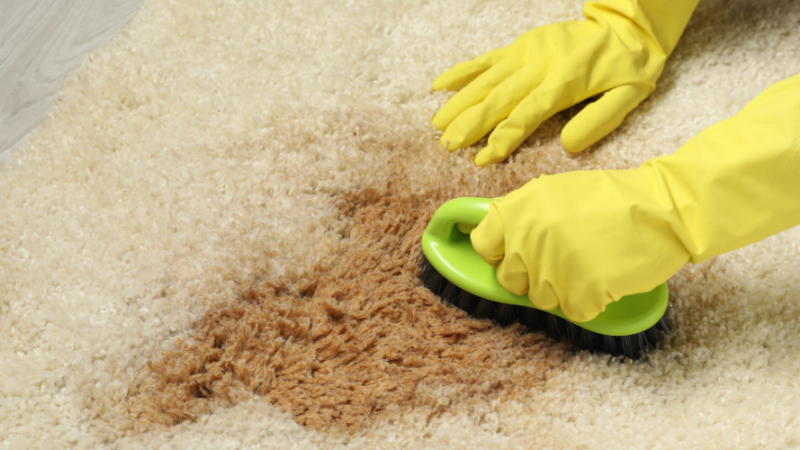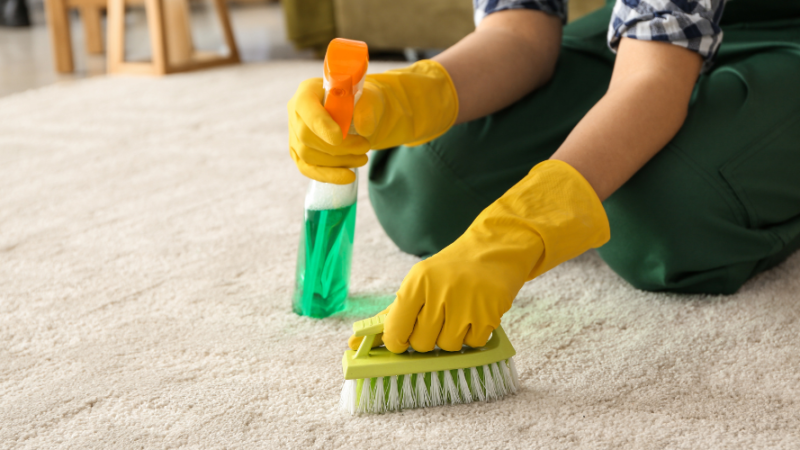Steam Cleaning vs. Dry Cleaning: Which is Better?
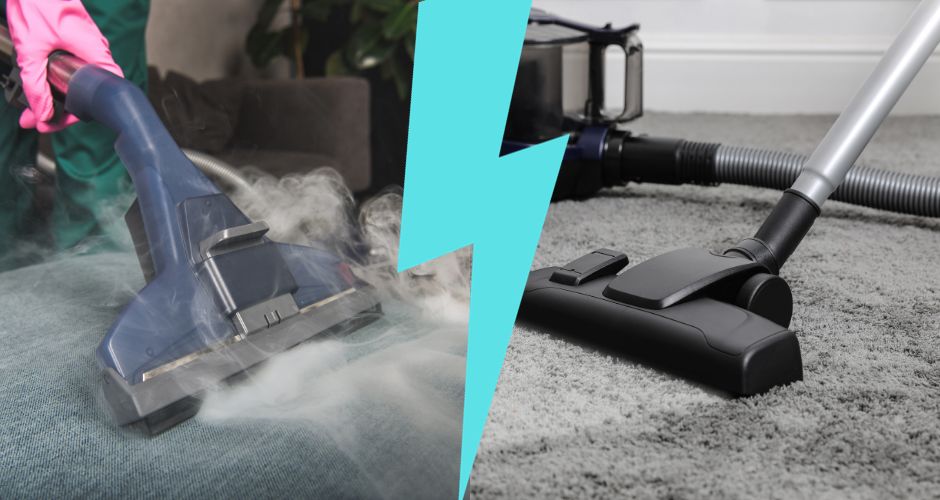
When it comes to keeping your carpets fresh, clean, and free from dirt and allergens, choosing the right cleaning method is key. Two of the most popular options are steam cleaning and dry cleaning, each offering unique benefits that cater to different needs.
Steam cleaning, with its deep cleaning power, is known for effectively removing dirt and bacteria, while dry cleaning offers a quicker, low-moisture solution that’s perfect for delicate fabrics. But which one truly reigns supreme?
By understanding the benefits of each, you can make an informed decision to keep your carpets spotless and inviting.
Let’s explore the battle of Steam Cleaning vs. Dry Cleaning!
Steam Cleaning
Steam cleaning, or hot water extraction, is a powerful technique for deep-cleaning carpets, effectively removing dirt, stains, and allergens. The process utilizes a specialized machine that injects hot water and detergent into carpet fibers, then swiftly extracts the solution along with the loosened dirt and debris. This method is renowned for its ability to refresh and sanitize carpets, making it a go-to choice for both homes and businesses alike.
Key Aspects of Steam Cleaning for Carpets
- Deep Cleaning: Steam cleaning penetrates deep into the carpet fibres, reaching areas that traditional vacuuming may not access. The combination of hot water and detergent helps break down and lift embedded dirt and stains.
- Sanitization: The high temperature of the steam used in the cleaning process provides a sanitizing effect. It effectively kills bacteria, viruses, dust mites, and other microorganisms, contributing to a healthier indoor environment.
- Removal of Allergens: Steam cleaning is particularly effective in removing allergens such as dust, pollen, and pet dander from carpets. This is beneficial for individuals with allergies or respiratory conditions.
- Versatility: Steam cleaning is suitable for various types of carpets and carpet fibres. It can be adapted to different pile heights and textures, providing a versatile solution for different carpeting materials.
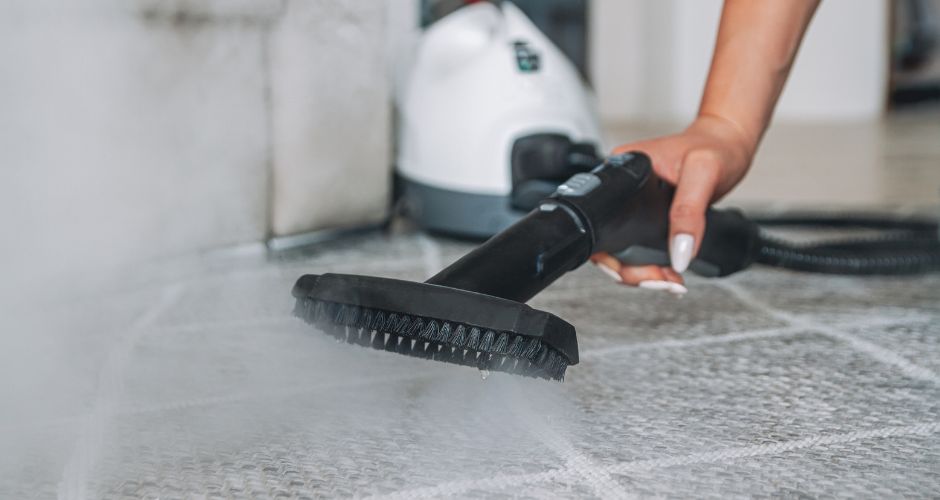
Process Overview
- Pre-Inspection: A thorough examination of the carpet to identify areas of heavy soiling, stains, or specific concerns.
- Pre-Treatment: Application of a pre-treatment solution to break down and loosen stubborn stains and soils.
- Hot Water Extraction: The steam cleaning machine injects hot water and detergent into the carpet fibres, followed by immediate extraction of the solution along with dirt and debris.
- Post-Cleaning Inspection: A final inspection to ensure that the cleaning process has effectively addressed all areas of concern.
Considerations
- Drying Time: While steam cleaning is highly effective, it can leave carpets damp. Adequate ventilation and air circulation are essential to facilitate faster drying and prevent mould or mildew growth.
- Professional vs. DIY: While there are consumer-grade steam cleaning machines available, professional services often provide more powerful equipment and expertise, resulting in a more thorough cleaning.
- Frequency: The frequency of steam cleaning depends on factors such as foot traffic, the presence of pets, and lifestyle. Periodic professional steam cleaning helps maintain carpet appearance and longevity.
“Are you unknowingly sabotaging your carpet’s longevity and cleanliness? Discover the common carpet cleaning mistakes to avoid for a healthier, more vibrant floor underfoot.”
Dry Cleaning
Dry carpet cleaning is a specialized technique that uses minimal water, making it ideal for carpets and rugs sensitive to moisture. Unlike traditional wet cleaning, dry cleaning involves applying cleaning compounds or powders to lift dirt, stains, and allergens. This method effectively refreshes carpets without requiring long drying periods.
Key Aspects of Dry Carpet Cleaning
- Low Moisture: Dry carpet cleaning minimizes the use of water, making it an ideal choice for carpets that can’t tolerate excess moisture. This is particularly beneficial for natural fibres like wool or for carpets with a risk of colour bleeding.
- Cleaning Compounds or Powders: Instead of liquid solutions, dry cleaning involves the application of specialized cleaning compounds or powders. These substances attract and encapsulate dirt and stains, allowing them to be easily vacuumed away.
- Quick Drying Time: The absence of significant moisture ensures that carpets dry quickly after dry cleaning. This is advantageous in environments where minimizing downtime is crucial, such as in commercial spaces.
- Spot Cleaning: Dry carpet cleaning is effective for spot cleaning and targeting specific areas of the carpet that require attention. It allows for precise treatment without affecting the entire carpet.
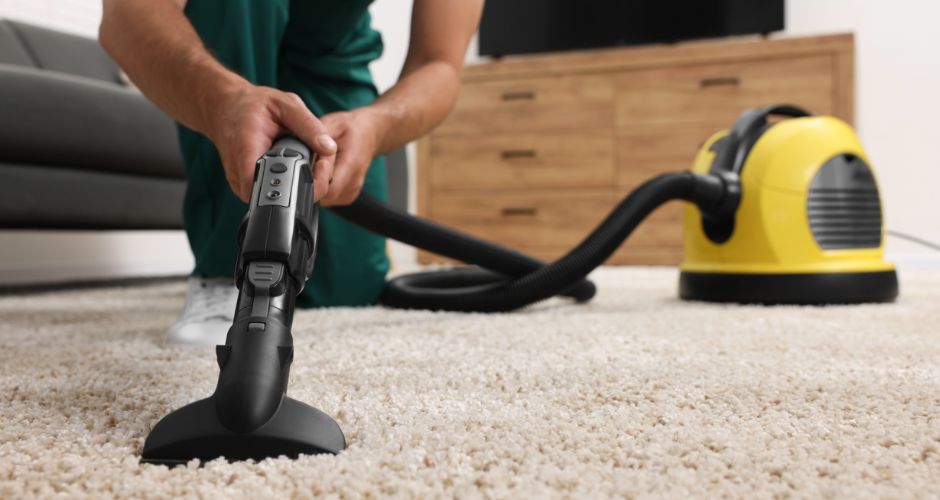
Considerations
- Effectiveness on Heavy Soiling: While dry cleaning is effective for regular maintenance and spot cleaning, it may not be as powerful as wet cleaning methods when dealing with heavily soiled carpets. In such cases, a combination of dry and wet cleaning techniques may be recommended.
- Chemical Sensitivity: Some individuals may be sensitive to the cleaning compounds or powders used in dry cleaning. It’s advisable to choose products that are labelled as hypoallergenic or environmentally friendly.
- Professional vs. DIY: While there are dry carpet cleaning products available for consumer use, professional services often yield more thorough results. Professional cleaners have access to advanced equipment and specialized products that may not be readily available to consumers.
- Carpet Material Compatibility: It’s essential to check the carpet manufacturer’s recommendations and care instructions to ensure compatibility with dry cleaning methods. Certain materials may benefit more from other cleaning approaches.
Steam Cleaning V/S Dry Cleaning
When it comes to maintaining the cleanliness of surfaces, especially carpets and upholstery, the choice between steam cleaning and dry cleaning is a decision that should be based on specific needs and considerations. Here’s a breakdown of the key differences between these two popular cleaning methods:
| Factor | Steam Cleaning | Dry Cleaning |
| Cleaning Method | Uses hot water and steam to clean surfaces. | Utilizes minimal or no water, relying on solvents or powders. |
| Effectiveness | Deep-cleans surfaces, removing dirt, stains, and allergens. | Effective for spot cleaning, targeted stain removal. |
| Sanitization | High-temperature steam provides a sanitizing effect. | Uses chemical solvents; may not have the same sanitizing effect. |
| Drying Time | Surfaces may remain damp, requiring adequate drying time. | Quick drying time due to minimal water usage. |
| Versatility | Suitable for various surfaces like carpets, upholstery, tiles. | Widely used for delicate fabrics and materials. |
| Environmental Impact | Generally eco-friendly with fewer chemical detergents. | Uses chemical solvents; environmental impact may vary. |
| Equipment Cost | Professional-grade machines may have a higher upfront cost. | Equipment may be more cost-effective for consumer use. |
| Spot Cleaning | Effective for overall deep cleaning; may not be as precise. | Ideal for spot cleaning and targeting specific stains. |
| Chemical Odor | Minimal chemical odors from detergents used in the process. | Some residual chemical odor may be noticed. |
| Material Compatibility | Versatile, suitable for a wide range of materials. | Suitable for delicate fabrics that may be damaged by water. |
| Professional vs. DIY | Professional services often yield more thorough results. | Consumer-grade products available for smaller tasks. |
In conclusion, the choice between steam cleaning and dry cleaning depends on factors such as the carpet type, specific cleaning needs, and considerations like drying time and environmental impact. Both methods have their strengths, and determining which is better for you involves evaluating these factors based on your unique circumstances.




